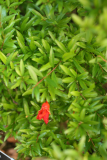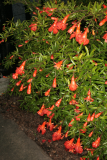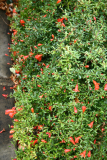Additional notes (click to expand)
Horticulture
The dwarf form of this species, Punica granatum var. nana has fruits no more than 3cm across.
Oakeley, Dr. Henry F. (2013). Wellcome Library notes.
link
Medicinal
Pomegranate, granatum malum, balustines.The Pomegranate is in the centre of the Arms of the Royal College of Physicians, perhaps for its use in cooling, and therefore for fevers. However it was the sour pomegranate that would have been used as Dioscorides says the sweet ones are unfit for use in agues. Culpeper (1650) makes no mention of the fruit, but says of the flowers ‘... they stop fluxes and the Terms in women.’ In the Complete Herbal and English Physician (1826) he says the fruit ‘... has the same general qualities as other acid fruits.’ Of the flowers he says (among other properties) that ‘A strong infusion of these cures ulcers in the mouth and throat, and fastens loose teeth.’ Gerard (1633) says that the cravings of pregnant women can be abolished with the juice, and perhaps it was scurvy which was being treated effectively when he reports that the juice was very effective against splitting of blood and for loose teeth. Pomegranate bark can only be sold by registered pharmacies in the UK. In South Africa the fruit rind is used for diarrhoea and stomach ache, and the bark as a vermifuge, but undesirable side effects make this dangerous. It is reported to be effective against fevers, as a diuretic, to lower blood sugar and to be both antibacterial and antiviral (van Wyk, 2000).
Oakeley, Dr. Henry F. (2013). Wellcome Library notes.
link
Nomenclature
Punica granatum 'Nana' = Synonym
Other use
Used to be used as a vermifuge, with the secondary use that the tincture made from it doubled as a permanent ink.
Oakeley, Dr. Henry F. (2013). Wellcome Library notes.
link
The following notes refer to the traditional uses of the species of this plant.
The pomegranate has a long history of herbal use dating back more than 3,000 years. All parts of the plant contain unusual alkaloids, known as 'pelletierines', which paralyse tapeworms so that they are easily expelled from the body by using a laxative. The plant is also rich in tannin, which makes it an effective astringent. It is used externally in the treatment of vaginal discharges, mouth sores and throat infections[ ]
https://pfaf.org Bown. D. Encyclopaedia of Herbs and their Uses. Dorling Kindersley, London. 1995
Punica granatum var. nana (L.) Pers.
Family: LYTHRACEAEGenus: Punica
Species: granatum L.
Variety: nana (L.) Pers.
Common names: Dwarf Pomegranate
Pharmacopoeia Londinensis name: Granatum malum
Distribution summary: E Mediterranean to Himalayas
Habit: Shrub
Hardiness: H5 - Hardy; cold winter
Habitat: Dry limestone soils
Garden status: Currently grown
Garden location: Pharmacopoeia Londinensis 1618 'Fruit' (HSE 4B)
Flowering months: June, July, August, September
Reason for growing: Other use
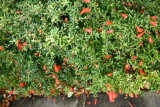
.JPG)
.JPG)
.JPG)
.JPG)
.JPG)
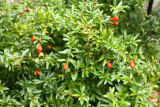
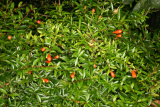
.JPG)
.JPG)
.jpg)
.jpg)
.jpg)


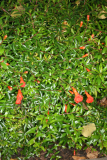
.JPG)
.JPG)
.JPG)
.JPG)
